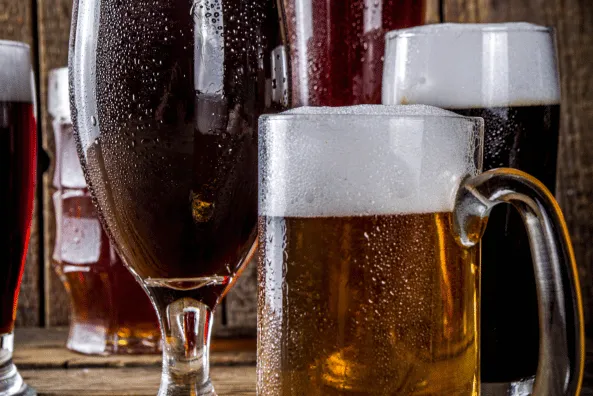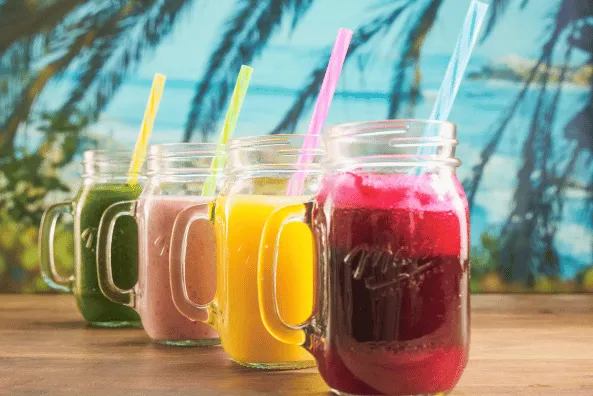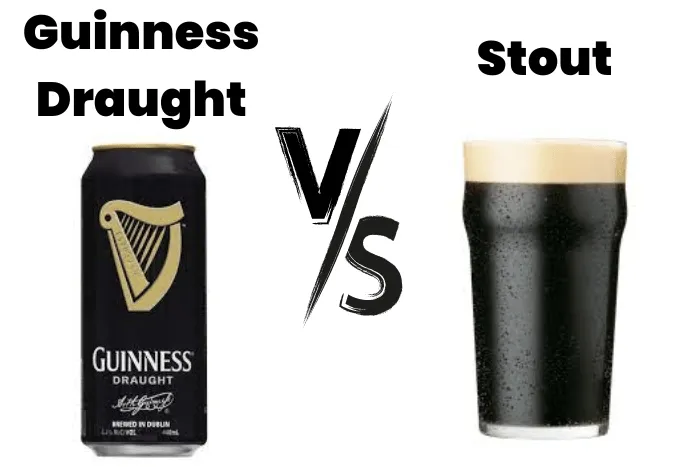Guinness Draught and Extra Stout are two of the most popular beers in the world. But what are the main differences between them? In this blog post, we’ll look at the origins, history, ingredients, fermentation and brewing process, flavor profile and mouthfeel, color, alcohol content, and international bitterness unit (IBU) of Guinness Draught vs. Extra Stout.
We’ll discuss how roasted and malted barley creates the characteristic taste that differentiates Guinness from other dark beers. Additionally, we’ll explore how nitro beer has changed drinking Guinness over time.
Furthermore, we will compare bottled versions versus draught versions and explain why many people believe drinking a pint of draught Guinness at their local pub is an experience like no other.
If you’re curious about one of Ireland’s most famous exports or love trying new types of beer – this blog post is for you! So sit back with your favorite brew while we closely examine everything “Guinness.”
Table of Contents:
- Origins and History
- Ingredients
- Fermentation and Brewing Process
- Flavor Profile & Mouthfeel
- Color , Alcohol Content And International Bitterness Unit(IBU)
- What People Are Saying
- FAQs in Relation to Guinness Draught vs Stout
- Conclusion
Origins of Guinness Draught
Guinness is an iconic beer, globally recognized and accessible. It has a rich history that dates back to 1759 when Arthur Guinness signed a 9,000-year lease on an old brewery at St. James’s Gate in Dublin, Ireland. He then began brewing his iconic dark beer, Guinness Draught.
Barley malt and hops, the two main components of Guinness, impart their signature flavor and texture. The roasted barley gives it its deep color, while the roast malt extract adds sweetness and body to the beer. Irish barley is also used for additional flavor complexity and nitrogenated gas for carbonation.
Origins of Guinness Stout
In 1959, bottled versions of Extra Stout and Foreign Extra Stout were released. These versions contain higher amounts of alcohol ranging from 5-7%, depending on where they are sold worldwide. Although slight variations exist between each type of beer brewed by Guinness today (Draught vs. Original vs. Foreign Extra), they all rely heavily on malted barley for their characteristic taste and aroma profile, making them instantly recognizable wherever you go.
The Guinness brand has a long and rich history that is still enjoyed today. The ingredients used to create the two types of beers, draught, and stout, are just as crucial in understanding their differences.
Guinness Draught vs Extra Stout : Ingredients

Guinness Draught and Extra Stout are two of the most popular beers from Guinness. They rely heavily on high-quality ingredients such as Irish barley malt and hops. Still, some differences affect their flavor profile, color, alcohol content, international bitterness unit (IBU), etc.
The two brews differ mainly in the malt type employed during production, with Draught utilizing a mixture of pale ale malts and Extra Stout relying on roasted barley to give it its distinct flavor and hue. For example, Guinness Draught uses a blend of pale ale malts, while Extra Stout uses roasted barley to give it its characteristic taste and dark color. Using roasted barley gives Extra Stout a higher IBU than its counterpart and makes it slightly more bitter than Draught.
In addition to using different types of malt for each beer variety, Guinness also relies heavily on hops for flavoring and aroma. For instance, Draught is brewed with Goldings hops which provide floral notes, while Extra Stout is made with Fuggles hops which impart earthy flavors into the brew. Both varieties also contain roast malt extract, which adds complexity to their flavor profiles and contributes to their distinct colors.
The ingredients used in Guinness Draught and Stout differ slightly, with the draught utilizing a combination of roasted barley and flaked barley while the stout is brewed with only roasted malt. Let’s investigate the carbonation and aging process for both Guinness Draught and Stout by analyzing their unique methods.
Guinness Draught vs Extra Stout : Fermentation and Brewing Process
The fermentation and brewing process is key to creating the perfect beer. Regarding Guinness, two of their most celebrated brews are the Draught and Extra Stout varieties. Both beers have different processes for fermentation and brewing that affect their flavor profiles, mouthfeel, color, alcohol content, and bitterness.
Carbonation Methods
The carbonation method used in each beer affects the overall taste of the beverage. For instance, Guinness Draught is nitrogenated, while Extra Stout is carbon dioxide-carbonated, which results in a creamier texture with smaller bubbles than traditional carbon dioxide-carbonated beers. It gives Draught its unique smoothness instead of Extra Stout’s more robust flavor profile.
Maturation Time
Maturation time also plays a vital role in determining how each beer tastes when served cold or at room temperature. Guinness Draught has a shorter maturation time of just over two weeks compared to Extra Stout’s three weeks before it can be sold commercially. As a result, draught has a lighter body and less intense flavors than extra stout due to its shorter maturation period. In contrast, extra stout develops more complex flavors from its more extended aging period before being released into stores for sale.
These differences between how Guinness’ two flagship beers are fermented and brewed make them distinct in terms of taste. Still, both offer delicious options for craft beer enthusiasts looking for something special on tap or out of the bottle/can form.
Guinness Draught vs Extra Stout : Flavor, Mouthfeel, Color, Alcohol Content & IBU

Flavor Profile & Mouthfeel
The two main types of Guinness are the Extra Stout and Draught, each with its distinct flavor profile and texture. The Extra Stout has a strong roasted malt aroma with hints of coffee, chocolate, and caramel. It is full-bodied with a smooth surface that coats your tongue. Sweet malty notes balance its bitterness for an overall pleasant drinking experience.
On the other hand, the Draught version has more subtle aromas of malt sweetness and some hoppy bitterness in the background. It’s lighter in the body than its counterpart but retains its creamy texture due to nitrogenation during fermentation.
Color
In terms of color differences between both beers, they range from deep ruby red to jet black depending on how long they have been aged or stored before consumption time. The color of Guinness, both Extra Stout and Draught, have distinct differences. The Extra Stout is a deep dark brown with ruby highlights, while the Draught has a golden hue that appears almost amber in certain lights. Both are full-bodied beers with creamy heads when poured correctly.
Alcohol Content
The alcohol content also varies slightly between both types at 4% ABV (Alcohol By Volume) for Draught and 5% ABV for Extra Stout, making them ideal choices as session beers if you’re looking for something light yet flavorful without too much alcohol content kick.
International Bitterness Unit (IBU)
Lastly International Bitterness Unit (IBU) which measures hop bitterness ranges from 40 IBU for Extra Stout up to 45 IBU for Draught giving drinkers another indicator when choosing what type suits their taste buds best.
Overall, the color, alcohol content, and International Bitterness Unit (IBU) of Guinness Extra Stout and Draught are distinct. Next, let’s explore the opinions of others regarding these two brews by examining feedback from various sources.
What People Are Saying About Guinness Draught and Extra Stout
Many beer connoisseurs agree that both brews have a distinct flavor profile that sets them apart from other beers. Though differing views exist, some individuals favor one of the two beers more than the other.
Guinness Extra Stout Reviews:
Those who enjoy a strong, robust flavor often opt for the extra stout version of this famous Irish beer. It has an ABV (alcohol by volume) content of 7% and an IBU (international bitterness unit) rating of 45-50. It tastes slightly bitter with notes of roasted barley malt and dark chocolate. Some people also describe its aroma as having hints of coffee or licorice due to its unique blend of hops used in brewing.
Guinness Draught Reviews:
This version is much lighter than its counterpart, with an ABV content of 4%. Its IBU rating is around 40, making it less bitter than the extra stout but still fully flavored enough to satisfy most craft beer drinkers’ palates. The draught’s malty sweetness, accompanied by notes of caramel and biscuit, is a less intimidating introduction to dark beer styles for those who don’t usually drink them.
There is no definitive answer when deciding between these two classic Irish ales; each offers something unique regarding flavor profile, mouthfeel, color, alcohol content, and international bitterness unit (IBU). Ultimately it is up to personal preference, so why not try both?
FAQs in Relation to Guinness Draught vs Stout
What is the difference between Guinness Draught and Guinness Draught stout?
Guinness Draught is a smooth, creamy, and velvety beer with an intense flavor of roasted barley. It has a mild hop bitterness that gives it balance. The alcohol content is 4.2% ABV (alcohol by volume). On the other hand, Guinness Draught Stout has more pronounced flavors than its lighter counterpart; it’s richer in body and taste due to higher levels of hops and roasted malt used during the brewing process, making it stronger at 5% ABV. Its dark color comes from using black malts, while the iconic creamy head can be attributed to nitrogen gas being injected into the beer as part of the brewing process.
Why is Guinness better on Draught?
Guinness on draught is a unique experience that cannot be replicated with any other beer. The nitrogen gas used to pour the beer creates an incredibly smooth and creamy texture. In contrast, the combination of malted barley, hops, and yeast creates a unique flavor profile that can only be experienced through draught Guinness. Additionally, pouring Guinness from a tap allows for more efficient carbonation than traditional methods, further enhancing its taste. Overall, this unique brewing process makes it so that no other beer can compare to the quality of Guinness on Draught.
Is it Guinness or Guinness Stout?
Guinness is a dry stout beer, first brewed in Dublin, Ireland, by Arthur Guinness in 1759. It has an iconic dark color and a creamy head with a distinctively smooth taste. The classic version of the drink is known as Guinness Draught or Original Extra Stout. Stout brewed using the same process as Guinness Original Extra Stout can vary in flavor due to different hops and malts used and is referred to as ‘Guinness Stout.’
What is the difference between Guinness Extra Stout and Guinness Foreign Extra Stout?
Guinness Extra Stout and Guinness Foreign Extra Stout are beers from the same brewery. The former is a dry stout with a 4.2% ABV, while the latter has an ABV of 7.5%. Both have roasted barley for flavor, but the extra stout contains more hops to give it a slightly bitter taste and fuller body than its counterpart. Additionally, extra foreign stout is brewed in Ireland using different ingredients that give it higher alcohol content and more robust flavor than regular Guinness Extra Stout, which is available worldwide.
Conclusion
In conclusion, there are many differences between the two beers when it comes to Guinness draught vs. stout. The origin and history of both types of beer differ significantly, as do their ingredients and brewing processes. In terms of flavor profile and mouthfeel, color, alcohol content, and IBU levels – they also vary significantly. Ultimately, it is up to each individual’s preference which type of Guinness beer they prefer drinking.
Look no further if you’re looking for the best beer reviews, equipment, subscription services, and brewing tips to help you make the perfect Guinness Draught or Stout. Our blog is packed with helpful information and advice to get your brewpub experience started!
Also Visit: Exploring the Differences Between IPA and Imperial IPA
